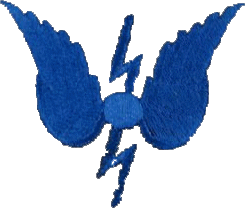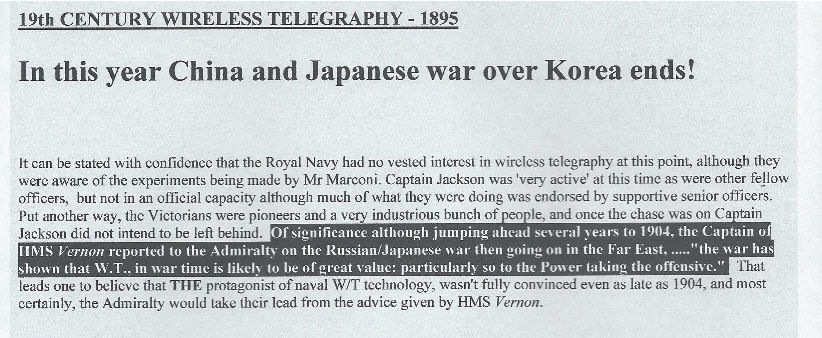


INTRODUCTION TO THE BOOKS IN THIS SERIES ON THE PERIOD1896 - 1899
©RN Communications Branch Museum/Library
©RN Radio and Radar
Torpedo warfare, or the potential for it, had been known about since the start of the 19th century in 1800. It was used mainly by the Confederates in the American Civil War (1860's) and after that War, its evolution was rapid so much so, that come 1912 over thirty navies were using the famous Whitehead Torpedo. Of course, the early torpedo's bear no resemblance to the WW1 self-propelled Whitehead torpedo, but the latter is very similar to modern day torpedo's discounting guidance and telemetry.
By 1879 the Royal Navy had established a TORPEDO SCHOOL and its very first annual report was submitted in this year. They continued in the same format year after year well into the 1920's, but ceased to be published after a major re-organisation of naval warfare and the many schools involved, each teaching a specific skill.
The early TORPEDO SCHOOL was responsible for TORPEDO's (and MINES of course) as well as GUNNERY, and as ELECTRICITY (and the facilities made possible by its introduction) came into common use, it too was added to HMS Vernon's growing list of responsibilities. One can image the trepidation of young recruits to the new science when they routinely saw signs like this; were instructed by dapper chappies like this guy and were ultimately to work with such inspiring colleagues like this rather dirty and unkempt tar.
In so many ways the Royal Navy has come a full circle, where today, HMS Collingwood is the lead school on all and everything remotely ELECTRICAL/ELECTRONIC which is EXACTLY what HMS Vernon was well over 100 years ago before the days of The Portsmouth Dockyard Signal School, HMS Excellent, HMS Mercury, HMS Dryad, HMS Collingwood where it wasn't until 1947 when the Electrical Branch was formed.
From HMS Vernon came the first naval electricians; the first naval radio electricians and the first radio operators albeit on a part time basis only. Vernon was the lead school/authority in all the radio system assessments [and there were many of them down the years] and its officers laid down the W/T rules and regulations prior to WW1. It was fitting therefore, that the very first SIGNAL SCHOOL should be built/established as an integral part of HMS Vernon, which was only moved to Leydene [East Meon] after the dockyard was heavily targeted by German bombers in WW2. The School's address at this time was "H.M. Signal School. R.N. Barracks. Portsmouth ETC"
As developing torpedo technology inspired the establishment of a school in 1879, then wireless technology warranted its own part of the school's annual report. From 1896 until 1899 this was published as a Chapter of the Main Report and from 1900 to 1913, as an Appendix to the Main Report which was a substantial bound book {8½" x 13½"} and as the technology evolved so too did the size of the printed Appendix. In 1914 at the beginning of WW1, W/T technology was still expanding and it was considered wise not to publish, except in secret form and distribution, the progress being made by the Royal Navy. After the war, the Appendix never returned to the Annual Report of Torpedo School, because by 1920, the Admiralty had commissioned the Admiralty Signal Establishment {ASE} [also at Portsmouth although it moved out of harms way at the opening stages of WW2 to Haslemere in Surrey, to Lythe House] and they took up the research and the reporting, albeit, still in a Secret manner: ASE eventually became ASRE {Admiralty Signal and Radar Establishment - lucky that Signals came before Radar !} and eventually to ASWE {Admiralty Surface Weapons Establishment} once again back in the premier naval port of Portsmouth. The Portsmouth Dockyard Signal School Report, like its former parent the Annual Torpedo School Report, continued first as an annual report then as a half-yearly report both supported by appendices and always with a classification of Secret. This sheet of paper from September 1936 is the lead-sheet to the 1936 half-yearly report No 7 - meaning, I would guess, that up to and including December 1932, annual reports were submitted and from the beginning of 1933 half-yearly's became the norm. Number 7 would be finalised up to the end of June 1936, written-up, published and printed for circulation in early September. Logical ? Certainly ! Moreover, because of that Secret caveat, it is more than likely that these documents with an extremely limited distribution dating from 1914 until post WW2, were all destroyed by burning, nothing less, with perhaps the odd copy or two, being locked away in a Government Archive. Here is a lead-sheet of the 1936 Signal School Half Yearly Report example
This PDF File, shows a typical annual report front cover and first few pages, this one from 1909 - note the mention of the Wireless Telegraphy Appendix under the date, and also in the Indexed Page Contents list. It is published to allow you to get a feel for the detailed and comprehensive technical navy of 100 years ago. Introduction These pages were always accompanied by a manpower report Manpower report.
| 1895 (without wires) |
 |
|
| 1896 | In this year first ever petrol-engined Flight - Deutschland Regrettably the Museum does not hold a copy of the official reports for the experiments of 1896 which are mentioned in the 1897 HMS Vernon report. This in itself, although desirable, is not a disaster because subsequently, in the 1897. pdf report, at page 109 under THEORY, the views expressed in the missing report were much altered in the light of experience. Throughout this site, where possible, we are using ROYAL NAVAL information only, but on this occasion we have researched the old 'Army and Navy Illustrated News' {ANIN} for mention of such data. This magazine, whilst always 'unofficial', was nevertheless closely aligned with the day to day happenings of the British Armed Forces and rarely missed a trick or a 'good' story. More than anything else, it "flew the flag" for both the War Office and the Admiralty and as such was a most respected journal. In every way it can be considered to be today's Navy News which serves the same purpose. However, it wasn't until this article of 1901 that mention was made of this up and coming naval Captain and his experiments of 1896. As you will shortly read, the euphoria experienced in 1896, though justly acclaimed and exciting, was relatively short-lived, because in the 1898 official HMS Defiance report, it states...."The experiments with the Telegraph without Connecting Wires which were commenced by Captain Jackson, and reported on in last years report, have been continued, but so far without such results as will justify the turning over of the apparatus to seagoing ships." The telegraph without wires was a proven science, but the navy was about going to sea to fight and it was still doing this using the tried and tested {although limiting} visual signalling techniques of flag hoists, semaphore and flashing light, whilst those on terra firma were left scratching their heads. | |
| 1897 | Admiralty orders two full powerful sets to be made ready for practical trials at sea. Captain Jackson's navy system sends signals over 5800 yards [3¼ miles] whilst Marconi achieves 21120 yards [12 miles] between two ships. Speed of Morse code is 10wpm, automatically recorded - no operator with pencil or earphones. Defiance and Scourge fits. Under induction coil, note the quaint expression 'rain-tight'. Connecting to Coil. Although not stated, Captain Jackson had a big advantage over Marconi, when he [the latter] was developing equipment on terra firma namely the sea and the wonderful natural earth it provided, whereas a good earth ashore was [and is] a real problem for engineers. In the receiver section, he explains the early coherer. Plates 27 and 28 are not marked on the pdf file but they are obvious as to which is which. Once set up, the tapper and receiver parts needed no further attention. In the Shunts section, today, we would call this a 'permanent mark'. Notice the advantages and the disadvantages, especially the first advantage when it states "In the event of the apparatus giving satisfactory results at sea", and later in the fifth advantage, the cables used between the Port Authority to communicate with ships in harbour. The lead into the disadvantages is all telling with a goodly amount of woe...."a bar to its [W/T] ever superseding the existing method [V/S]. | Captain Jackson's Report |
| 1898 | A Mr Preece' W/T Trial at Dover. Vertical wire aerial tests. The perceived problem of omni-directional properties which, dare I say it, was considered as, and spoke of, as being "EVIL" ! Thickness [or gauge] of wire used at a TX and at a RX. Marconi experimenting at Salisbury Iron cables versus copper. Best spark discharge to suit aerials under test. Poor induction coil - great improvements necessary - present system "not filled for use by untechnical persons." {If words like unintelligent, unassuming etc etc are still in use, why today, do we say non-technical ?} Note the interesting effects of resonance on tuning. Coherer's - Marconi's is the most sensitive, however not very stable and the tubes are likely to crack. Maximum constraints are 1mA/1.5V otherwise the sensitivity is destroyed rapidly. Coherer's of moderate sensitivity are more stable assuming the constraints above are adhered to. Sensitivity is determined by the amount of Mercury used in the Coherer. Experiments in 1892 over land and sea proved that the sea hindered the E/M waves less than the land. Parabolic reflectors and Righi transmitters. λ/0.25 and λ/0.75 of the oscillations produced. Best achieved distance over which communications were possible was a mere three quarters of a mile. Mr Marconi's experiments of 7th May 1898 carried out at the Needles and reported on by Commander Hornby R.N. Success at 14½ miles using 10wpm. Distance directly related to vertical height of aerial; 30' being allowed for 1 mile, 60' for 4 miles and 120' for 16 miles. Height to be achieved using balloons and kites although good vertical heights could be achieved on ships. {To communicate with Hong Kong would have required a rocket launch but one still attached to earth}. Limitations all round when only one frequency [waveband or Tune] was available. Marconi to provide different Tunes so that two [or more] ships can communicate simultaneously with causing interference. Sparks flying around everywhere, and operators receiving nasty shocks HMS Defiance report on Telegraphy Without Wires. The reasons why a seagoing system is, as yet, difficult to manufacture. |
|
| 1899 | Lieutenant Salwey's report on the equipment fitted into HMS Europa for the 1899 peace manoeuvres. |
1899 Wireless Telegraphy Report 1899 Submarine Telegraphy 1899 HMS Vernon's X-ray machines |


